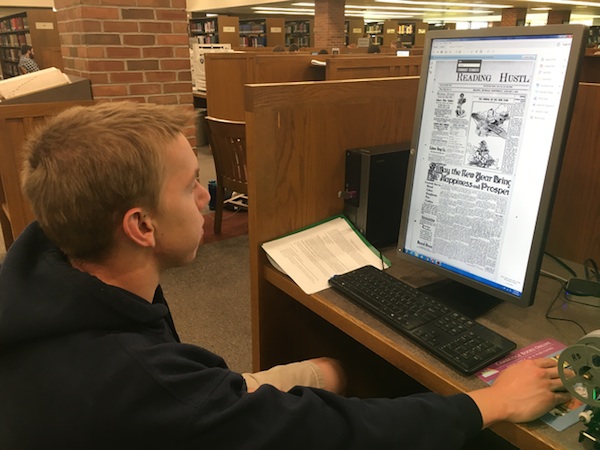
Not everyone in Mossey Library this week is stumbling through hell week.
A handful of GOAL volunteers devote an hour a week each to digitizing the 23 microfilms housing old editions of The Reading Hustler, a weekly newspaper, dating from 1891 to about 1953. They are led by Debbie Reister, a member of the Mitchell Research Center since 2009 and the housedirector of Kappa Kappa Gamma since 2013.
“It’s a really great opportunity to interact with these old newspapers as a history major,” junior Joshua Schmid said. “I definitely plan on continuing to do it next year, and if there are any other people, history majors, I highly suggest it to them as well, or just to anyone who’s interested in genealogy.”
According to GOAL Program Leader senior Alexis Garcia, the archiving effort isn’t quite a GOAL program because it would need a bigger scope, more potential for growth, and more students involved. It does, however, fall under the GOAL umbrella because the program essentially handles all volunteer opportunities.
The Mitchell Research Center is a volunteer genealogical research center. When Reister and the other volunteers received the films, they looked for a digitization machine to convert the microfilms — 50- or 60-year-old technology starting to show signs of wear and tear — to digital files and preserve them for future researchers.
But there was a problem: a digitization machine costs $12,000, Reister said, which was too much for the volunteer group. The vendor of these machines, however, pointed Reister to the college’s library. After working with the Hillsdale College Archivist Linda Moore and contacting Garcia, the Mitchell Research Center secured use of the microfilm reader and digitizer as well as student volunteers.
“We’re a volunteer organization, so that’s why it was so kind of the college to communicate with the community to let us do this,” Reister said. “It was kind of a nice connection to help people.”
Reister said the digitization process is time-consuming because the pages need correcting, whether it’s adjusting brightness or straightening them.
Occasionally, volunteers can find the hand of whoever spent their time converting old newspapers into microfilms a half-century ago.
“It was a little eerie seeing the image of that hand,” Schmid said.
For Reister, it’s also fun to read the pages as she puts them in the computer. She said she’s excited for upcoming sessions because she has just reached the World War I years of the newspaper.
“It’s very interesting to see how people treated each other the same way we treat people now,” Reister said. “We think about mass media as not having been before the phone, but they used newspapers to communicate who was in town. It was a weekly thing, it was a little bit less timely.”
Most people looking up information about their families rely on birth and wedding announcements and obituaries in papers. They are also digitizing wills and divorce certificates.
“We do whatever we can do for them to help them track back their families,” Reister said.
Reister said people from as far away as Wisconsin come to the Mitchell Research Center because they had family in the county. Also, many people who come in are seeking to provide proof their lineages go back to people on the Mayflower or in the American Revolution so they can be a part of Daughters of the American Revolution or the Mayflower groups.
For Reister, this kind of project is not just an interesting way to step back in time, but it’s also in her blood.
“My great-grandmother was a founding member of the Daughters of the American Revolution in Lenawee County,” Reister said. “My mother has cupboards and cupboards of records. And I keep coming back to it.”

